I learned a new word yesterday. A”locavore” is someone who only eats food that has been produced and procured locally, typically within a 100 mile radius. The idea is that food transported over great distances is lower in quality and stamps a larger carbon footprint than the locally grown, fermented, concocted or processed version; locavores vote with their forks by supporting local producers (all the rage) and contributing less to the causes of global warming.
Though I can’t find the word in the dictionary, there are apparently varying degrees of such an eater: a “strict locavore” is someone who won’t touch oil or vinegar with a 10-foot pole if it doesn’t fit the criteria, and the “wild card locavore”, who will make concessions for things like sugar and coffee and other far flung, foreign luxuries. Regardless of the degree of locavore, it is such a romantic and impractical idea. Who would honestly cut sugar and coffee from their diet if it wasn’t grown locally? You can’t tell me those people aren’t cheating. Plus, a locavore living in an area that actually cannot produce things like “fruit” or “vegetables” would have rather a hard time trying to make a go of it. The idea irks me because it seems like one more thing or practice that is available only to a lucky few, like driving a Prius. I find it hard to give those drivers, and locavores, too much credit for doing their part because their contributions are luxuries, not necessities. If truly inspired by the need to limit the effects of global warming, wouldn’t a locavore’s efforts be better applied to petitioning a mass transit system to go hybrid or convincing their employer and co-workers to reduce electricity consumption? That a locavore would be lauded as a crusader against the production of greenhouse gases is laughable.
At any rate, it got me to thinking about our most recent meals and how close they come to being locavorous (now I’m inventing words). Almost all the food we buy is local by default because it’s California and there is almost nothing that won’t grow here. However, even with these exceptional circumstances on our side, we do not qualify as locavores.
First, there is the Crab, Mango and Avocado Salad with Citrus Dressing.  Because we can’t afford to pay $35/lb for fresh lumps of crab meat, we bought some canned stuff from India. The mango came from Mexico. The honey came from Austria and the olive oil is strangely somehow a “product of California and Tunisia”. (what?) Everything else – which is just the veg – was locally grown. Incidentally, though this sounds like it would be nothing but delicious, it was kind of bland.
Because we can’t afford to pay $35/lb for fresh lumps of crab meat, we bought some canned stuff from India. The mango came from Mexico. The honey came from Austria and the olive oil is strangely somehow a “product of California and Tunisia”. (what?) Everything else – which is just the veg – was locally grown. Incidentally, though this sounds like it would be nothing but delicious, it was kind of bland.
Second, there is the Spicy Sesame Noodle Salad with Chopped Peanuts and Thai Basil. 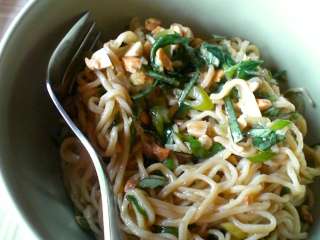 Sesame oil from Taiwan, soy sauce brewed in Wisconsin, kosher salt from Minneapolis, balsamic from Italy, and vegetable oil from Nebraska. I can’t figure out where the sugar came from and the Chinese noodles were actually made fresh by the Berkeley Bowl. Had I not made a point of looking for this information, I wouldn’t have given it a second thought. And yet, look how far all this stuff came just for me to make a salad! It’s actually pretty impressive. The salad itself made a great lunch but next time we’ll make it spicier.
Sesame oil from Taiwan, soy sauce brewed in Wisconsin, kosher salt from Minneapolis, balsamic from Italy, and vegetable oil from Nebraska. I can’t figure out where the sugar came from and the Chinese noodles were actually made fresh by the Berkeley Bowl. Had I not made a point of looking for this information, I wouldn’t have given it a second thought. And yet, look how far all this stuff came just for me to make a salad! It’s actually pretty impressive. The salad itself made a great lunch but next time we’ll make it spicier.
Last, there is Green Herb Risotto to which we added grilled shrimp with marjoram and fresh tarragon. 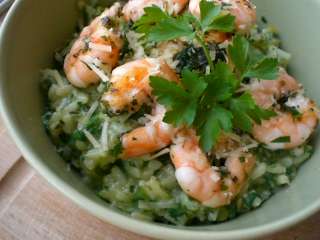 Except for the organic, free-range chicken broth (Oregon), the rice (Argentina) and the olive oil (California and Tunisia), it was made with local ingredients. Lucky for us, our kitchen is practically in the ocean and is next door to Napa valley; this meal would have been far more foreign had we made it in Calgary. The improvised shrimp was the best part.
Except for the organic, free-range chicken broth (Oregon), the rice (Argentina) and the olive oil (California and Tunisia), it was made with local ingredients. Lucky for us, our kitchen is practically in the ocean and is next door to Napa valley; this meal would have been far more foreign had we made it in Calgary. The improvised shrimp was the best part.
Now that I’ve actually taken the time to find out where my food comes from, it becomes clear that it would take considerable effort (relative to the amount of greenhouse gases that would not be produced) to become a locavore, even in the food-heaven of the Bay area. I will not be drawn into this romantic trend. And I will never give up coffee.
For the record, lately we have been walking more and driving so little that we’ve used less than half a tank of gas in six weeks. Does that make us less culpable in the battle against global warming? Possibly- but you can be sure we’d be driving alot more if we weren’t lucky enough to be in a position to have the option not to.
 After some initial searching online, this project divided itself into two parts: 1) scaling & cleaning, and 2) boning (shouldn’t it be “de-boning”?). I’m impressed with how many people have taken the time to publish the directions on how to do the first bit, and I found a great one, with pictures, on
After some initial searching online, this project divided itself into two parts: 1) scaling & cleaning, and 2) boning (shouldn’t it be “de-boning”?). I’m impressed with how many people have taken the time to publish the directions on how to do the first bit, and I found a great one, with pictures, on 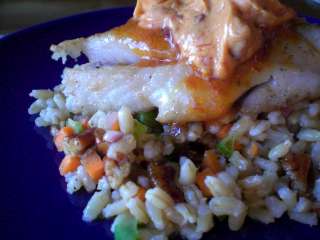 As for the meal, I’m not sure it really did the snapper justice. The chipotle butter was a little too overpowering for a white-fleshed fish and the barley salad a little too mild. This didn’t stop us from consuming every last drop of melted butter but I doubt we’ll make it again. Similarly, I doubt the cleaning and/or scaling will happen again any time soon, but fileting seems like something I should know so I’ll practice. And if ever I hit a snag, I know my ubiquitous teacher will bail me out.
As for the meal, I’m not sure it really did the snapper justice. The chipotle butter was a little too overpowering for a white-fleshed fish and the barley salad a little too mild. This didn’t stop us from consuming every last drop of melted butter but I doubt we’ll make it again. Similarly, I doubt the cleaning and/or scaling will happen again any time soon, but fileting seems like something I should know so I’ll practice. And if ever I hit a snag, I know my ubiquitous teacher will bail me out. This smoothed the way for the “barbequed” pork tenderloin, which had been soaking in the flavour of smoked paprika for the previous hour. Marc finished baking the ciabatta he had started earlier in the day for the buns and I pickled the onions in orangey vinegar. While the sandwiches were manifesting, we remembered to make the caprese which was a dead simple job of grilling a bit of eggplant, laying it down with sliced heirloom tomatoes, and fresh mozzarella, with a topping of a quick grilled-tomato vinaigrette. As a stretch, I suppose this salad could qualify as a yankee-themed “red, white and blue” meal because of the red of the tomatoes and the white of the mozzarella on the blue plates, but the best representation of this theme was the dessert.
This smoothed the way for the “barbequed” pork tenderloin, which had been soaking in the flavour of smoked paprika for the previous hour. Marc finished baking the ciabatta he had started earlier in the day for the buns and I pickled the onions in orangey vinegar. While the sandwiches were manifesting, we remembered to make the caprese which was a dead simple job of grilling a bit of eggplant, laying it down with sliced heirloom tomatoes, and fresh mozzarella, with a topping of a quick grilled-tomato vinaigrette. As a stretch, I suppose this salad could qualify as a yankee-themed “red, white and blue” meal because of the red of the tomatoes and the white of the mozzarella on the blue plates, but the best representation of this theme was the dessert.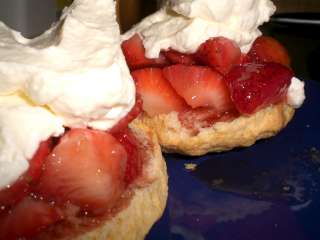 I threw together some pre-margarita biscuits to be the bottom of this classic version of strawberry shortcake. I think every other time I’ve tried this dessert, it was made with white cake and Cool Whip™ which doesn’t even come close to the true incarnation. Plus, strawberries, when they’re fresh and not picked under-ripe and shipped across half a continent, taste so much better. I added a little balsamic vinegar to the strawberries and sugar mixture, which juiced itself into a pulpy, perfumed compote and put a bit of extra-high-fat sour cream into the chantilly. Piled up high, these shortcakes were a fantastic celebration of American-ness and a perfect opener for the fireworks over the bay.
I threw together some pre-margarita biscuits to be the bottom of this classic version of strawberry shortcake. I think every other time I’ve tried this dessert, it was made with white cake and Cool Whip™ which doesn’t even come close to the true incarnation. Plus, strawberries, when they’re fresh and not picked under-ripe and shipped across half a continent, taste so much better. I added a little balsamic vinegar to the strawberries and sugar mixture, which juiced itself into a pulpy, perfumed compote and put a bit of extra-high-fat sour cream into the chantilly. Piled up high, these shortcakes were a fantastic celebration of American-ness and a perfect opener for the fireworks over the bay.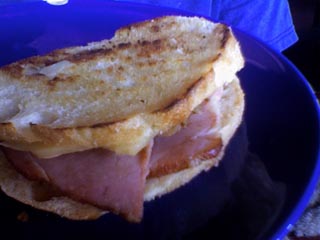 Baking fresh ciabatta started the morning well and set me up to make a wicked sandwich for lunch. Taking a cue from the
Baking fresh ciabatta started the morning well and set me up to make a wicked sandwich for lunch. Taking a cue from the 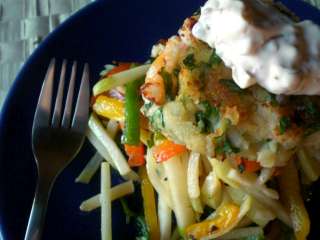 Marc found a recipe that called for chayote just so we could taste what it’s all about. It turns out that it tastes fine – sort of like a cucumber – but the
Marc found a recipe that called for chayote just so we could taste what it’s all about. It turns out that it tastes fine – sort of like a cucumber – but the 
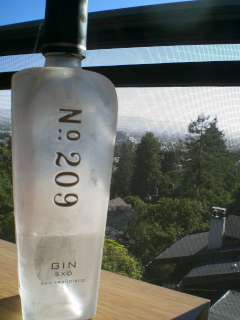
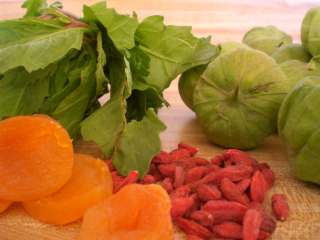


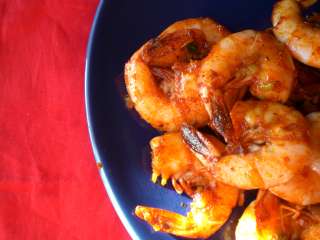
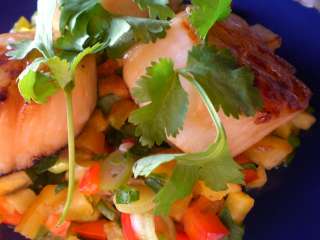

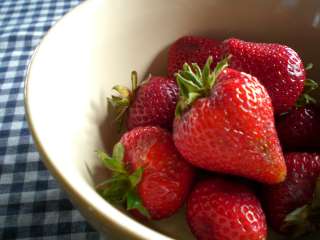

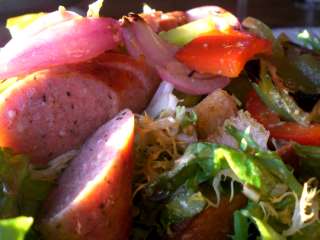
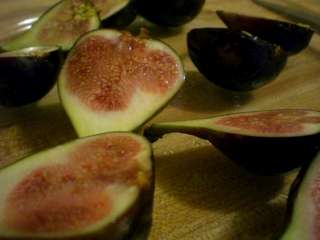 Last night, for dessert, I roasted some fresh, Mission figs with honey and cream. If we had a broiler, I would’ve broiled them, like the description in the book, “Under The Tuscan Sun” but we don’t and I didn’t. They were not perfect – and not organic, BTW, even though that option was available at twice the price – but they still tasted lovely.
Last night, for dessert, I roasted some fresh, Mission figs with honey and cream. If we had a broiler, I would’ve broiled them, like the description in the book, “Under The Tuscan Sun” but we don’t and I didn’t. They were not perfect – and not organic, BTW, even though that option was available at twice the price – but they still tasted lovely.